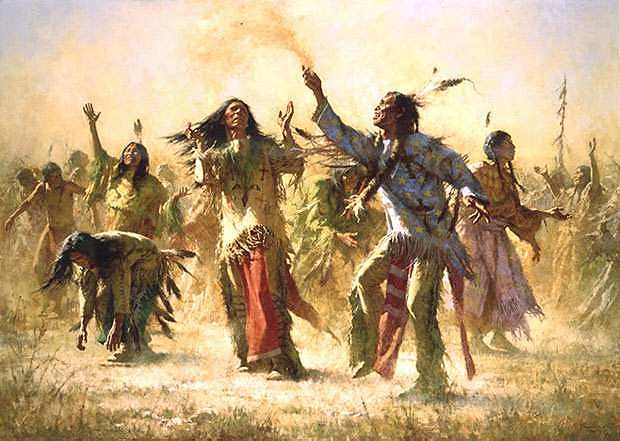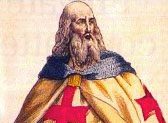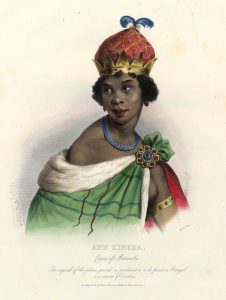The Ghost Dance, introduced by the Northern Paiute tribe, was a ceremony that acted as a hope to bring back prosperity and liveliness to all of the natives who had fallen under attacks and displacements from their homelands by white American settlers. These Ghost Dances sought to unify the tribe and bring their people together in the hope of returning to their previous ways of living; it was through this Ghost Dance that a strong connection to the spirit world was maintained. Dating back to its beginning in Nevada in 1869, the Ghost Dance was introduced by the visions of the prophet Tävibo, a Northern Paiute. He spoke of a time when Indians would once again be prosperous and no longer be under the control of white people, claiming that white people would disappear altogether. This would allow native Americans to return to the life they once had before the Europeans came, and their buffalo would once again be plentiful. This was the wish many Indians held, to return and resume to act in their cultural ways with no interruption. Tävibo also claimed that in introducing the Ghost Dance, he had spoken to their deceased ancestors. He claimed that it was these dead family members who contrived and shaped the dance into a circular performance dance ceremony. This supposed interaction with the dead and their overall influence on the living is how the name of the practice came to be called the Ghost Dance. The dance grew in popularity as it spread throughout the land, over the great plains to Nevada and California, and even to Oregon.1

During the following years, other prophets emerged, but the Ghost Dance did not continue to see widespread appeal until the appearance of another prophet, said to be Tävibo’s son. His name was Wovoka, but he was also known as Jack Wilson. Wovoka was born into the Northern Paiute tribe, but at age fourteen his father died. This left Wovoka to be raised by a white family, on the nearby ranch. By joining David Wilson’s family, Wovoka worked on the ranch and was given the name of Jack Wilson. He become accustomed to many new ways, such as the English language and the Christian religion. While he lived under this new household for years, as he became an adult he rejoined the Paiute tribe. In time, he too was said to experience visions from a higher power, or supreme being, and he spread his teachings among the tribe. Wovoka preached that his people should learn to live peacefully, for the time being, with the newcomers. Just as Tävibo had done, Wovoka also introduced dances and songs thought to have been passed on from their Indian ancestors. Wovoka expressed that if these ceremonies were performed, and if they exhibited their practices of peace, then their land too would become free of white people. Not only would a banishment of the white Americans come, but Wovoka also claimed there would be a resurrection of the deceased, and that all would be reunited with those who had passed.2
The dance would last for four days; it was a round dance that united the entire tribe. During the dance some would take fans that were woven from the wings of eagles and fan those partaking in the round dance. This act was said to put the dancers into a trance, and while submerged, those in the trance would see their relatives who had passed on to the afterworld. The dancers would see them in a place of complete serenity. The lives they were living were the ones of the past where all were happy and under no oppression, with the supply of buffalo easily at hand.3
Those who followed the teachings of Tävibo were not necessarily followers of Wovoka. But in contrast to that, the Ghost Dance was welcomed among the Plain tribes across many states, including Kansas, Oklahoma, Nebraska, Texas, and the Dakotas. The words and practices of Wovoka reached as far as the Cheyenne, Arapaho, Kiowa, Wichita, Caddo, and Apache tribes. The numbers of those participating in a single ceremony often exceeded three thousand, as groups gathered to dance every night for two weeks during a single Ghost Dance. The greatest influence reached the Lakota Sioux, who brought the dance into practice. Wovoka was consulted and listened to by the Sioux, and they took his message to heart. By 1890, Wovoka was speaking of the Ghost Dance bringing about the resurrection of their deceased ancestors. He also claimed that herds of buffalo would return in abundance, and that whites would not only leave, but would be annihilated by natural disasters, leaving Indians to their peaceful solitude once again. All wished to return to the life before any contact with the Europeans had occurred. The message that the Ghost Dance was trying to fulfill was not of hatred or rebellion, but one of returning their people to the culture and life they had enjoyed before the coming of white settlers. The Ghost Dance gave them hope that such times were yet to come. These tribes were suffering dreadful conditions, which had been forced on them, forcing them to reside in ever narrowing reservations. The Lakota people were the ones who went beyond the dance and even introduced adding special garments to the Ghost Dance ceremony. They began wearing ghost shirts that were adorned with symbols. But these shirts were not only considered a matter of simple decor, but were thought of as pieces of protection. It was a belief of the Lakotas that these shirts would resist harm from coming to them, and that even bullets would not penetrate these shirts.4

As more white citizens became aware of the Ghost Dance ceremonies being practiced by tribes around them, they sensed a threat by them and became alarmed. The U.S. Indian Policy, more specifically The Dawes Act, was believed to have been under attack by these dances and it created a fear among the white people of an uprising from the Indians. It is even said that officials, especially those who ran the reservations, saw that a war was being ignited by the Lakotas. Even the act of wearing the decorated shirts in practice of the dance fomented the idea that the Lakotas were forming and instigating the makings of a battle. In fear, the officials of the reservations called on the United States government. The president at the time, Benjamin Harrison, responded by sending the U.S. Army down to these reservations to stop the threat, hoping to end the potential conflict that was believed to be rising between the Indians and whites. This resulted in Indian leaders, such as Sitting Bull, being arrested and, unfortunately in this act, killed.5
On December 23, 1890, the Miniconjous Lakotas fled and escaped their reservation village after being struck with fear. From the words of John Dunn, a local squatter, the military had planned to take the Lakota men and deport them to an island in the Atlantic Ocean. With this news, the Miniconjous Lakotas ran, but after five days, the tribe was found by the Seventh Cavalry, who were sent to intervene. The Lakotas were sent to reside in confinement on Wounded Knee Creek. By the next morning, December 29, Colonel James W. Forsyth ordered that the tribe surrender all firearms. In back and forth arguments, some Lakotas engaged in the songs of the Ghost Dance. Once again, the Ghost Dance was interpreted as a threat. Some Indians began throwing handfuls of dirt in the air, and this was seen as a signal of attack. This ignited the soldiers who were supervising the reservations. In a quarrel over a rifle, Black Coyote refused to surrender his gun to a soldier who had demanded it. During the tug of war and struggle to get the gun, it accidentally fired. Because of this sudden shot, troops opened fire because they were under the assumption that they were indeed under attack and needed to regain order. The Lakotas, who had no weapons, did all they could do to flee the situation. The military fired their weapons and chased down all that attempted to escape, killing along the way. The gunfire continued for hours as the military pursued the Lakotas. This occurrence became known as the Wounded Knee Massacre. Between 145 to 300 Indian followers died, many of these victims being women and children. In the attempt to gather all bodies, some were found even three miles away from the reservation. One-hundred-forty-six Lakotas were buried in a mass grave, while the others were gathered and accounted for later.6

While the military lost only twenty-five men, it was celebrated among the white people as a success. People believed that the “savage ways” of the Indians may finally be over. The Medal of Honor was presented to twenty individuals for their acts during the massacre at Wounded Knee, as their actions was seen as being extremely heroic. The Wounded Knee Massacre was the final blow to the Indians as this ended the four hundred year conflict between the whites and the natives. In only ten years, the Indian population reached a low of 250,000 people. This massacre resulted in the Ghost Dance ceremonies dying out among the Lakotas, but elsewhere in the plain, the acts continued. In some areas as far away as Canada, the Ghost Dance was practiced well into the 1960’s. The ceremonial Ghost Dance holds a rich cultural importance to all of those who were a part of it. It was an expression of native tribes longing for the return of their happy, prosperous, and unbothered lives before the introduce of white settlers. It shows the practice as being completely connected with ones spirituality, in that it reunites members to those who have passed. It highlights how important culture is to native Indians by the acts of dancing, singing songs, and the clothing they put on their bodies. The true purpose of these Ghost Dances was to inspire hope, and it continues to do so in that it shows that even today this Indian culture should not die out as time progresses.
- Encyclopedia of The Great Plains, 2011, s.v. “Ghost Dance,” by Todd M. Kerstetter. ↵
- Encyclopedia of The Great Plains, 2011, s.v. “Ghost Dance,” by Todd M. Kerstetter. ↵
- Salem Press Biographical Encyclopedia, 1995, s.v. “Wovoka,” by Ronald W. Long. ↵
- The Encyclopedia of Oklahoma History and Culture, 2009, s.v. “Ghost Dance,” by Gloria A. Young. ↵
- The Encyclopedia of Oklahoma History and Culture, 2009, s.v. “Ghost Dance,” by Gloria A. Young. ↵
- Encyclopedia of The Great Plains, 2011, s.v. “Wounded Knee Massacre,” by John E. Carter. ↵



97 comments
Muhammad Hammad Zafar
The suspenseful part was the ghost dance and the confusion it sadly led to. Another main point is focusing on learning anything and doing the opposite of it. There was havoc in the society as so many people suffered by looking forward to the killing of natives by white people. At first, I didn’t catch the idea but later, in the end, I was understanding. I enjoyed it a lot as it was feeling like a movie.
Griffin Palmer
I found it to be interesting how the Native Americans used their religious practices in dire times. The ghost dance helps them with having hope that their way of life will return. Many other tribes become intrigued by this and would become involved as well. However, this would cause the Americans to become concerned and it would result in the Dawes Act which would turn Native Americans into farmers and landowners.
Griffin Palmer
I found it to be interesting how the Indians used their religious practices in dire times. The ghost dance helps them with having hope that their way of life will return. Many other tribes become intregued
Danielle Rangel
This article is a great way to show how religion and belief empowers groups of people like the Native Americans. I think it is interesting how the blending of religions and inspiration of a religion caused unity amongst the tribes. This is a great article that illuminates the threat native Americans posed to the United States despite being in separate locations. This was an amazing article!
Iris Reyna
The article was very well put together and was great at explaining the Native culture and what happened at the Wounded Knee Massacre. It was truly heartbreaking to read what happened at this event that was meant to bring hope to the Natives. It’s sad to see that a misunderstanding caused such a massacre to happen. This continues to happen during the present time. It just shows that we need to revisit history so that we do not repeat it.
Guiliana Devora
I genuinely feel bad for the Native Americans and everything that has happened to them because of the expansion of the United States. A dance that should have spread peace and hope turned into something that resulted in the exact opposite of that. I feel as though America needs to learn from the history and to never repeat what we did to them. History is important because without it, civilization will just keep repeating itself and never learn.
Bryon Haynes
What I like best about this article is something that is mentioned very early on. The fact that this rite was always performed with peace in mind, with the purpose of uniting the tribe as a result. So much of what is appropriated towards the indigenous peoples of America is the idea that they are homicidal monsters who never gave the Europeans a chance to create true coexistence on both sides, but this was never the case. Their resources were misused, and people were slain, yet peace was all they ever sought.
Clarissa Liscano
The article did a great job of explaining the ghost dance and the wounded knee massacre in great detail. I was able to learn how little white people care regarding learning anything about native culture and how they did the exact opposite by causing war to break out when they tried to reunite the natives with their land. How much horror the native people endured as a result of white males slaughtering literally hundreds of native people.
Rigel
Amazing article! I loved the way you structured the article, explaining the cultural significance of the ghost dance, and the misunderstandings it tragically led to. I am barely learning about the Wounded Knee Massacre, so learning that it was caused by white people misunderstanding the cultural significance of the Ghost Dance hurts in a way I really can not explain.
Lyle Ballesteros
Really well written article and thank you sharing all this information in a very detailed manner. It is a very interesting and ultimately depressing situation. I never knew the history of the Wounded Knee Massacre in this much detail and that the US army took to such violence and murder instead of looking to understand or just ignoring what the natives were doing in their own time. They were just trying to have hope for their lives and the future of their tribes and people that the White European settlers took away from them.